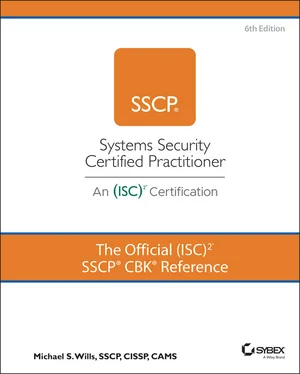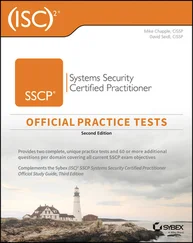Mike Wills - The Official (ISC)2 SSCP CBK Reference
Здесь есть возможность читать онлайн «Mike Wills - The Official (ISC)2 SSCP CBK Reference» — ознакомительный отрывок электронной книги совершенно бесплатно, а после прочтения отрывка купить полную версию. В некоторых случаях можно слушать аудио, скачать через торрент в формате fb2 и присутствует краткое содержание. Жанр: unrecognised, на английском языке. Описание произведения, (предисловие) а так же отзывы посетителей доступны на портале библиотеки ЛибКат.
- Название:The Official (ISC)2 SSCP CBK Reference
- Автор:
- Жанр:
- Год:неизвестен
- ISBN:нет данных
- Рейтинг книги:4 / 5. Голосов: 1
-
Избранное:Добавить в избранное
- Отзывы:
-
Ваша оценка:
- 80
- 1
- 2
- 3
- 4
- 5
The Official (ISC)2 SSCP CBK Reference: краткое содержание, описание и аннотация
Предлагаем к чтению аннотацию, описание, краткое содержание или предисловие (зависит от того, что написал сам автор книги «The Official (ISC)2 SSCP CBK Reference»). Если вы не нашли необходимую информацию о книге — напишите в комментариях, мы постараемся отыскать её.
The Official (ISC)2 SSCP CBK Reference
SSCP Study Guide
The Official (ISC)2 SSCP CBK Reference
The Official (ISC)2 SSCP CBK Reference — читать онлайн ознакомительный отрывок
Ниже представлен текст книги, разбитый по страницам. Система сохранения места последней прочитанной страницы, позволяет с удобством читать онлайн бесплатно книгу «The Official (ISC)2 SSCP CBK Reference», без необходимости каждый раз заново искать на чём Вы остановились. Поставьте закладку, и сможете в любой момент перейти на страницу, на которой закончили чтение.
Интервал:
Закладка:
A developer who writes code for a software release can't also be a tester for that same release or be the one who approves or moves that release into the production environment. If a developer put a flaw into that code maliciously, it will be intentionally allowed to pass. If the flaw was introduced accidentally or through ignorance or poor training, there is a chance the developer will just miss it again in testing. Involving a second person in the testing process allows the organization the opportunity to catch the mistake or malicious flaw.
An emergency has arisen, and an administrator needs to access a superuser account to perform a sensitive task that is far above their normal level of permissions. Authentication to that account requires a specific hardware token, which must be obtained from the shift lead at the SOC. The SOC lead verifies with the administrator's supervisor and/or verifies that there is an outage, incident ticket, or some other valid reason why the superuser token must be used before issuing it, and the token must be returned when the incident is resolved.
While implementing separation of duties, keep a few additional considerations in mind. First, separation of duties must be well-documented in policies and procedures. To complement this, mechanisms for enforcing the separation must be implemented to match the policies and procedures, including access-level authorizations for each task and role. Smaller organizations may have difficulty implementing segregation of duties, but the concept should be applied to the extent possible and logistically practical. Finally, remember that in cases where it is difficult to split the performance of a task, consider compensating controls such as audit trails, monitoring, and management supervision.
Another, similar form of process security is dual control . In dual control, two personnel are required to coordinate the same action from separate workstations (which may be a few feet or miles apart) to accomplish a specific task. This is not something reserved to the military's release of nuclear weapons; it is inherent in most cash-handling situations and is a vital part of decisions made by risk management boards, loan approval boards, and many other high-risk or safety-critical situations.
A related concept is two-person integrity , where no single person is allowed access or control over a location or asset at any time. Entry into restricted areas, such as data centers or network and communications facilities, might be best secured by dual control or two-person integrity processes, requiring an on-shift supervisor to confirm an entry request within a fraction of a minute.
Separation of duties is often seen as something that introduces inefficiencies, especially in small organizations or within what seem to be simple, well-bounded sequences of processes or tasks. As with any safeguard, senior leadership has to set the risk appetite or threshold level and then choose how to apply that to specific risks.
These types of risk mitigation controls are often put in place to administratively enforce a separation of duties design. By not having one person have such end-to-end responsibility or opportunity, you greatly reduce the exposure to fraud or abuse. In sensitive or hazardous material handling and manufacturing or in banking and casino operations, the work areas where such processes are conducted are often called no lone zones , because nobody is allowed to be working in them by themselves. In information systems, auditing, and accounting operations, this is sometimes referred to as a four-eyes approach for the same reason. Signing and countersigning steps are often part of these processes; these signatures can be pen and ink or electronic, depending upon the overall security needs. The needs for individual process security should dictate whether steps need both people (or all persons) to perform their tasks in the presence of the others (that is, in a no lone zone) or if they can be done in sequence (as in a four-eyes sign/countersign process).
Safety considerations also should dictate the use of no lone zones in work process design and layout. Commercial air transport regulations have long required two pilots to be on the flight deck during flight operations; hospital operating theaters and emergency rooms have teams of care providers working with patients, as much for quality of care as for reliability of care. Peer review, structured walkthroughs, and other processes are all a way to bring multiple eyes and minds to the process of producing high-quality, highly reliable software.
Note that separation of duties does not presume intent: It will protect the innocent from honest mistakes while increasing the likelihood that those with malicious intent will find it harder, if not impossible, to carry out their nefarious plans (whatever they may be). It limits the exposure to loss or damage that the organization would otherwise face if any component in a vital, sensitive process fails to function properly.
Separation of duties, for example, is an important control process to apply to the various event logs, alarm files, and telemetry information produced by all of your network and systems elements.
Of course, the total costs of implementing, operating, and maintaining such controls must be balanced against the potential impacts or losses associated with those risks. Implementing separation of duties can be difficult in small organizations simply because there are not enough people to perform the separate functions. Nevertheless, separation of duties remains an effective internal control to minimize the likelihood of fraud or malfeasance and reduce the potential for damage or loss due to accident or other nonhuman causes.
 Separation of Duties and Least Privilege: It's Not Just About Your People!
Separation of Duties and Least Privilege: It's Not Just About Your People!
In many business settings, the dual concepts of separation of duties and least privilege are seen as people-centric ideas—after all, far too much painful experience has shown that by placing far too much trust and power in one person's hands, temptation, coercion, or frustration can lead to great harm to the business. Industrial process control, transportation, and the military, by contrast, have long known that any decision-making component of a workflow or process can and will fail, leading also to a potential for great harm. Separation of duties means that autopilot software should not (one hopes!) control the main electrical power systems and buses of the aircraft; nor should the bid-ask real-time pricing systems of an electric utility company direct the CPUs, people, and actuators that run its nuclear reactors or turbine-powered generators.
Air gaps between critical sets of duties—gaps into which systems designers insert different people who have assessment and decision authority—become a critical element in designing safe and resilient systems.
Access Control and Need-to-Know
As you should expect, these key control principles of need to know, separation of duties, and least privilege also drive the ways in which you should configure and manage identity management and access control systems, as shown in Chapter 2. Best practices for implementing and managing any IAM system include:
Create hierarchies of groups of user identities and accounts, with privileges assigned to limit users to the least privileges they require for related tasks and functions.
Use role-based access control as part of your strategies so that one system or user must explicitly re-authenticate as they change roles to perform more privileged sets of tasks.
Create nonprivileged user accounts and identities for systems administrators, and others with privileged accounts, and enforce their use for tasks that do not require elevated privileges (such as email or routine web page access).
Читать дальшеИнтервал:
Закладка:
Похожие книги на «The Official (ISC)2 SSCP CBK Reference»
Представляем Вашему вниманию похожие книги на «The Official (ISC)2 SSCP CBK Reference» списком для выбора. Мы отобрали схожую по названию и смыслу литературу в надежде предоставить читателям больше вариантов отыскать новые, интересные, ещё непрочитанные произведения.
Обсуждение, отзывы о книге «The Official (ISC)2 SSCP CBK Reference» и просто собственные мнения читателей. Оставьте ваши комментарии, напишите, что Вы думаете о произведении, его смысле или главных героях. Укажите что конкретно понравилось, а что нет, и почему Вы так считаете.












